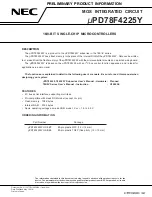
5-352
D60 Line Distance Protection System
GE Multilin
5.8 INPUTS AND OUTPUTS
5 SETTINGS
5
VIRTUAL OUTPUT 1 ID:
"Trip"
VIRTUAL OUTPUT 1 EVENTS:
"Disabled"
5.8.5 REMOTE DEVICES
a) REMOTE INPUTS AND OUTPUTS OVERVIEW
Remote inputs and outputs provide a means of exchanging digital state information between Ethernet-networked devices.
The IEC 61850 GSSE (Generic Substation State Event) and GOOSE (Generic Object Oriented Substation Event) stan-
dards are used.
The sharing of digital point state information between GSSE/GOOSE equipped relays is essentially an extension to Flex-
Logic, allowing distributed FlexLogic by making operands available to/from devices on a common communications net-
work. In addition to digital point states, GSSE/GOOSE messages identify the originator of the message and provide other
information required by the communication specification. All devices listen to network messages and capture data only from
messages that have originated in selected devices.
IEC 61850 GSSE messages are compatible with UCA GOOSE messages and contain a fixed set of digital points. IEC
61850 GOOSE messages can, in general, contain any configurable data items. When used by the remote input/output fea-
ture, IEC 61850 GOOSE messages contain the same data as GSSE messages.
Both GSSE and GOOSE messages are designed to be short, reliable, and high priority. GOOSE messages have additional
advantages over GSSE messages due to their support of VLAN (virtual LAN) and Ethernet priority tagging functionality.
The GSSE message structure contains space for 128 bit pairs representing digital point state information. The IEC 61850
specification provides 32 “DNA” bit pairs that represent the state of two pre-defined events and 30 user-defined events. All
remaining bit pairs are “UserSt” bit pairs, which are status bits representing user-definable events. The D60 implementation
provides 32 of the 96 available UserSt bit pairs.
The IEC 61850 specification includes features that are used to cope with the loss of communication between transmitting
and receiving devices. Each transmitting device will send a GSSE/GOOSE message upon a successful power-up, when
the state of any included point changes, or after a specified interval (the
default update
time) if a change-of-state has not
occurred. The transmitting device also sends a ‘hold time’ which is set greater than four times the programmed default time
required by the receiving device.
Receiving devices are constantly monitoring the communications network for messages they require, as recognized by the
identification of the originating device carried in the message. Messages received from remote devices include the mes-
sage
time allowed to live
. The receiving relay sets a timer assigned to the originating device to this time interval, and if it
has not received another message from this device at time-out, the remote device is declared to be non-communicating, so
it will use the programmed default state for all points from that specific remote device. If a message is received from a
remote device before the
time allowed to live
expires, all points for that device are updated to the states contained in the
message and the hold timer is restarted. The status of a remote device, where “Offline” indicates non-communicating, can
be displayed.
The remote input/output facility provides for 32 remote inputs and 64 remote outputs.
b) LOCAL DEVICES: ID OF DEVICE FOR TRANSMITTING GSSE MESSAGES
In a D60 relay, the device ID that represents the IEC 61850 GOOSE application ID (GoID) name string sent as part of each
GOOSE message is programmed in the
SETTINGS
PRODUCT SETUP
COMMUNICATIONS
IEC 61850 PROTOCOL
GSSE/GOOSE CONFIGURATION
TRANSMISSION
FIXED GOOSE
GOOSE ID
setting.
Likewise, the device ID that represents the IEC 61850 GSSE application ID name string sent as part of each GSSE mes-
sage is programmed in the
SETTINGS
PRODUCT SETUP
COMMUNICATIONS
IEC 61850 PROTOCOL
GSSE/GOOSE
CONFIGURATION
TRANSMISSION
GSSE
GSSE ID
setting.
In D60 releases previous to 5.0x, these name strings were represented by the
RELAY NAME
setting.
Содержание D60
Страница 61: ...GE Multilin D60 Line Distance Protection System 2 31 2 PRODUCT DESCRIPTION 2 3 SPECIFICATIONS 2 ...
Страница 62: ...2 32 D60 Line Distance Protection System GE Multilin 2 3 SPECIFICATIONS 2 PRODUCT DESCRIPTION 2 ...
Страница 102: ...3 40 D60 Line Distance Protection System GE Multilin 3 3 DIRECT INPUT AND OUTPUT COMMUNICATIONS 3 HARDWARE 3 ...
Страница 134: ...4 32 D60 Line Distance Protection System GE Multilin 4 3 FACEPLATE INTERFACE 4 HUMAN INTERFACES 4 ...
Страница 508: ...5 374 D60 Line Distance Protection System GE Multilin 5 10 TESTING 5 SETTINGS 5 ...
Страница 538: ...6 30 D60 Line Distance Protection System GE Multilin 6 5 PRODUCT INFORMATION 6 ACTUAL VALUES 6 ...
Страница 610: ...10 8 D60 Line Distance Protection System GE Multilin 10 2 BATTERIES 10 MAINTENANCE 10 ...
Страница 622: ...A 12 D60 Line Distance Protection System GE Multilin A 1 PARAMETER LISTS APPENDIX A A ...
Страница 745: ...GE Multilin D60 Line Distance Protection System B 123 APPENDIX B B 4 MEMORY MAPPING B ...
Страница 746: ...B 124 D60 Line Distance Protection System GE Multilin B 4 MEMORY MAPPING APPENDIX B B ...
Страница 776: ...C 30 D60 Line Distance Protection System GE Multilin C 7 LOGICAL NODES APPENDIX C C ...
Страница 792: ...E 10 D60 Line Distance Protection System GE Multilin E 1 IEC 60870 5 104 PROTOCOL APPENDIX E E ...
Страница 804: ...F 12 D60 Line Distance Protection System GE Multilin F 2 DNP POINT LISTS APPENDIX F F ...
Страница 826: ...xii D60 Line Distance Protection System GE Multilin INDEX ...
















































